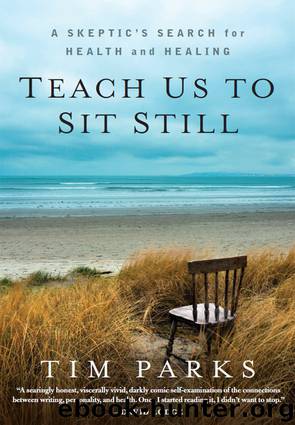Teach Us to Sit Still: A Skeptic's Search for Health and Healing by Tim Parks

Author:Tim Parks [Parks, Tim]
Language: eng
Format: epub
Tags: Health & Fitness, Body; Mind & Spirit, General, Personal Memoirs, Healing, Biography & Autobiography
ISBN: 9781609614485
Google: wbxjAQAAQBAJ
Publisher: Rodale
Published: 2010-01-02T00:00:00+00:00
Thus spake Dr Wise.
The muscles involved were primarily those of the pelvic floor, above all the marvelously named levator ani, and the book included disquieting images, as if from inside the body looking downward, of a finger poking up through the anus to explore and massage these muscles. Each diagram explained where the muscle in question tended to ‘refer pain.’
Once the trigger points had been identified and palpitated by expert massagers in the Stanford clinic, patients would be provided with a special stick or ‘wand’ (the Aneros perhaps) so that they could massage these points themselves. At home.
I wondered if I would ever rise, or sink, to such a do-it-yourself treatment. On my back, knees raised, a fairy wand up my butt. Or on all fours . . .
Best not to think about it.
Some of the offending muscles, however, were more easily and modestly accessible from the outside, in the thighs, around the groin, in and just above the buttocks. One of those that most referred pain to the bladder, my preferred hot spot, was the quadratus lumborum, the muscle that, at each side, attaches the pelvis to the spine. Checking the quadratus lumborum on Wikipedia, I found a detailed description of its susceptibility to deterioration as a result of constant contraction during prolonged periods of sitting, particularly sitting at desks, most particularly sitting at computers. The Wiki contributor then added the following reflection:
This chain of events can be and often is accelerated by kyphosis [a hunched spine] which is invariably accompanied by ‘rounded shoulders,’ both of which place greater stress on the QLs [quadratus lumborum muscles] by shifting body weight forward, forcing the erector spinae, QLs, multifidi, and especially the levator scapulae to work harder in both seated and standing positions to maintain an erect torso and neck.
In short, by not standing or sitting straight but rather peering forward from bent shoulders, I was stressing, among others, a muscle which, in its deteriorated state was known to refer pain to the bladder. Was this, I wondered, why the hunched Leopardi, his youth wasted, as he beautifully lamented, hunched over his ‘sudate carte’ (sweated pages), had had his peeing problems and bellyache so young? With advanced scoliosis at eighteen, he’d already screwed up his quadratus lumborum. And how uncanny that an idea that had suddenly come to me as I walked along the street one day—if only you walked tall, Tim, you would be better—an idea I quickly dismissed as foolish fancy, might actually have been a genuine insight.
As if my body knew things that I didn’t! Or I knew things my mind didn’t.
But how can you learn to stand up straight in your fifties?
Day after day I lay on my back, eyes closed, breathing, concentrating on tension where I found it. At worst it was dull, disheartening, unconvincing. My attention slipped from its object like a man climbing an ice wall in ballet shoes. To latch onto things, I needed words. But words can only describe sensation, not experience it.
Download
This site does not store any files on its server. We only index and link to content provided by other sites. Please contact the content providers to delete copyright contents if any and email us, we'll remove relevant links or contents immediately.
Inner Engineering: A Yogi's Guide to Joy by Sadhguru(5894)
The Power of Now: A Guide to Spiritual Enlightenment by Eckhart Tolle(4754)
Fear by Osho(4085)
The Art of Happiness by The Dalai Lama(3382)
The Ultimate Bodybuilding Cookbook by Kendall Lou Schmidt(3317)
Yoga Therapy by Mark Stephens(3222)
Ikigai by Héctor García & Francesc Miralles(3141)
The Little Book of Hygge by Meik Wiking(3080)
Why Buddhism is True by Robert Wright(2826)
The Healing Self by Deepak Chopra(2795)
Being Aware of Being Aware by Rupert Spira(2706)
Shift into Freedom by Loch Kelly(2692)
Wild Words from Wild Women by Stephens Autumn(2587)
Work Clean by Dan Charnas(2562)
Happiness by Matthieu Ricard(2522)
The Hatha Yoga Pradipika (Translated) by Svatmarama(2481)
Yoga Body & Mind Handbook by Jasmine Tarkeshi(2464)
More Language of Letting Go: 366 New Daily Meditations by Melody Beattie(2442)
Why I Am Not a Feminist by Jessa Crispin(2239)
